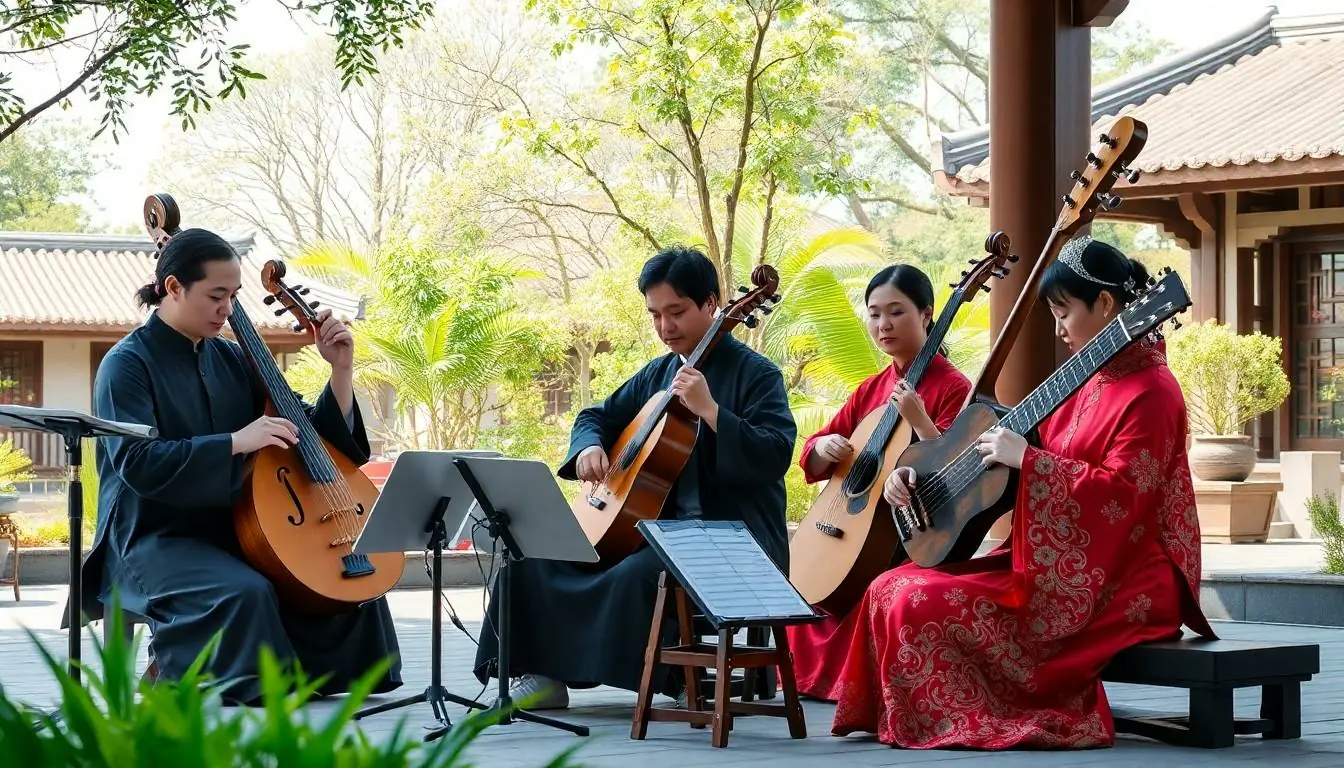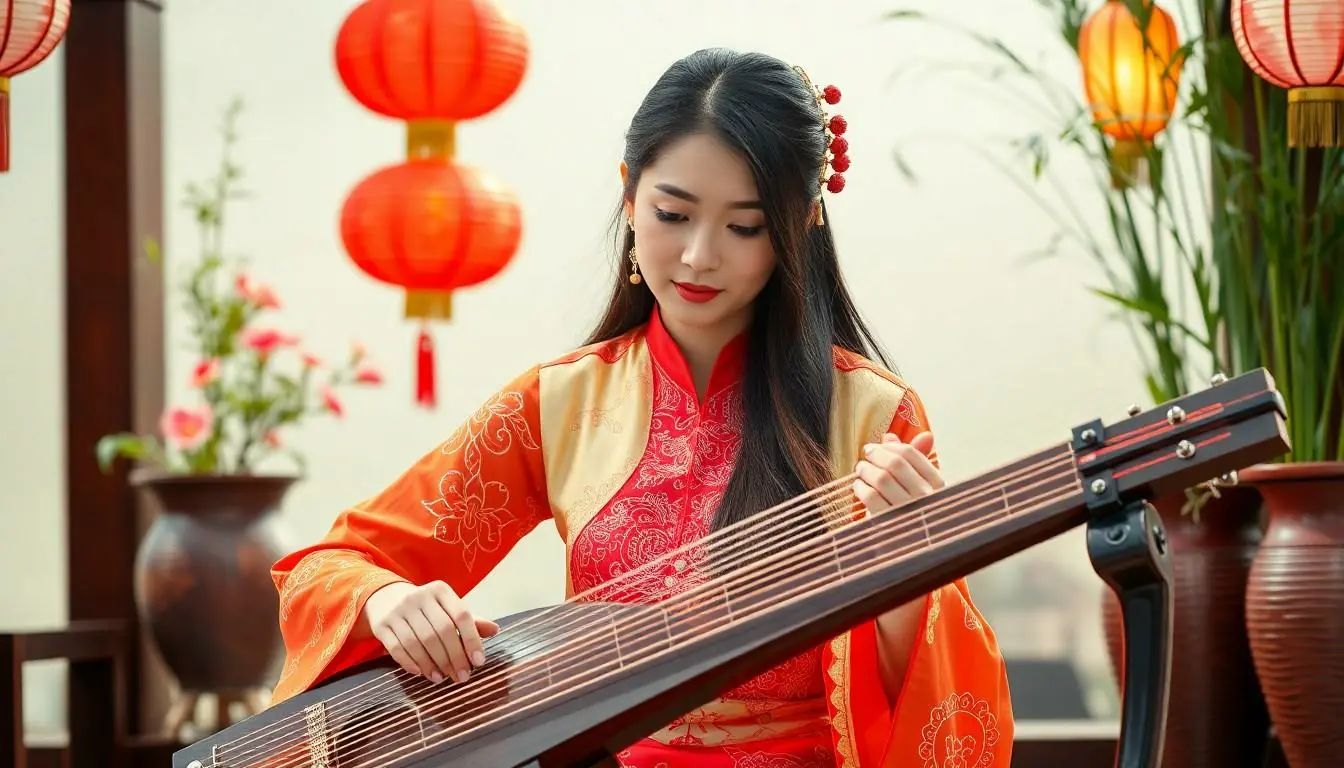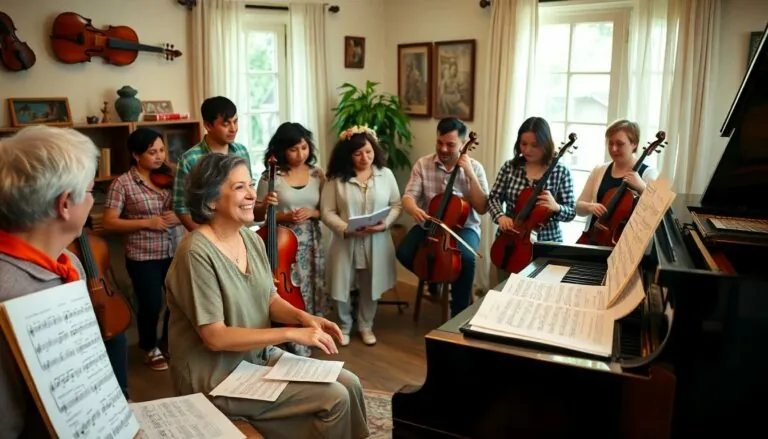Table of Contents
ToggleImagine a world where every note tells a story, where each melody transports you to ancient dynasties and serene landscapes. Chinese classical music isn’t just a genre; it’s a journey through time, filled with rich history and cultural depth. From the haunting sounds of the erhu to the delicate plucking of the guzheng, this musical tradition captivates the soul and tickles the ears.
But wait, don’t let the term “classical” fool you into thinking it’s all stiff and formal. This music has a playful side too! Picture musicians weaving intricate tales with their instruments, as if they’re in a lively conversation with the audience. Dive into the enchanting world of Chinese classical music, where every performance is a delightful blend of tradition and creativity that’s sure to leave you wanting more.
Overview of Chinese Classical Music
Chinese classical music encompasses a diverse range of styles and forms, deeply rooted in history. This genre, known for its intricate melodies, emphasizes the emotional expression of musicians. Instrumentation varies significantly; traditional instruments include the guzheng, erhu, and pipa, each contributing unique sounds.
Regional diversity also defines this musical landscape. Different areas showcase distinct musical traditions, reflecting local cultures. For instance, the Jiangnan Sizhu ensemble highlights silk and bamboo instruments, while the Beijing opera emphasizes narrative and character through music.
Notation systems play a crucial role in preserving this art form. The gongche system, a traditional method, uses simple characters to represent musical notes. This method allows musicians to learn and perform pieces passed down through generations efficiently.
Performances of Chinese classical music often occur in various contexts like festivals, operas, and formal concerts. Customarily, these performances evoke rich storytelling and emotional depth. Musicians interpret classical pieces with personal flair, making each performance a unique experience.
Cultural significance remains evident in the connection between music and philosophical concepts. Many compositions embody principles of Confucianism and Buddhism, aiming to convey harmony and balance. This intentional marriage of music and ideology enriches the listening experience.
Overall, Chinese classical music offers a complex and nuanced glimpse into the country’s artistic heritage. It invites appreciation for not only technical skill but also the storytelling aspect intrinsic to each composition.
Historical Context

Chinese classical music boasts a rich and varied history, reflecting the nation’s cultural evolution and artistic expression over centuries. This genre emerges from ancient traditions that shaped its development through different historical periods.
Ancient Origins
Origins date back over 3,000 years to the Shang Dynasty, where ritual music played a vital role in ceremonies. Instruments like the chimes and flutes provided harmonious sounds that complemented rituals. Notably, the “Book of Songs,” an early collection of poetry, includes musical references that illustrate the genre’s deep-rooted cultural significance. Such early compositions emphasized emotions and storytelling, laying the groundwork for future musical forms.
Evolution Through Dynasties
Each dynasty contributed unique elements to Chinese classical music. The Zhou Dynasty embraced new instruments and formalized notation systems, enhancing musical complexity. During the Tang Dynasty, globalization influenced music as foreign instruments and styles integrated into existing traditions. Innovations continued through the Song and Ming dynasties, leading to diversified regional styles. By the Qing Dynasty, musical drama and performance became popular, showcasing intricate narratives and emphasizing theatrical elements. This evolution ensured a dynamic and responsive art form, continuously adapting to cultural and social changes.
Key Characteristics
Chinese classical music features unique elements that distinguish it within the broader musical landscape. Its intricate melodies, emotional depth, and rich instrumentation provide a captivating listening experience.
Instrumentation
Instrumentation plays a vital role in defining the sound of Chinese classical music. The guzheng offers a striking, zither-like quality that resonates beautifully. The erhu, a two-stringed fiddle, contributes a haunting and expressive sound, showcasing its ability to convey deep emotions. The pipa, a four-stringed lute, adds both plucked and percussive sounds. Various other traditional instruments, including the dizi (bamboo flute) and sheng (mouth organ), further enrich the ensemble. Each instrument possesses distinct techniques, allowing musicians to express a wide range of feelings while maintaining cultural authenticity.
Musical Forms and Structures
Musical forms and structures in Chinese classical music exhibit a blend of tradition and creativity. Common forms include the Jiangnan Sizhu, which emphasizes ensemble playing, and Zheng, a solo performance style. Improvisation holds significance, allowing musicians to showcase technical skill while responding to the emotional landscape of the piece. The structure often relies on ABA arrangements, where themes recur with variations, enhancing the storytelling aspect. Modern compositions may incorporate fusion elements, but traditional forms remain foundational, keeping the essence of this historic art form alive and engaging.
Prominent Composers and Performers
Chinese classical music features a range of prominent composers and performers who have significantly shaped its evolution through history.
Historical Figures
Zhang Yong is known for his contributions during the Tang Dynasty. His compositions highlighted emotional narratives that resonated with audiences. Another influential figure, Chen Gang, emerged during the late Qing Dynasty. He integrated Western techniques while preserving traditional forms, expanding the genre’s appeal. Wang Luobin focused on folk music, revitalizing regional styles through innovative arrangements. Together, these historical figures played pivotal roles in establishing a foundation that continues to inspire contemporary musicians.
Modern Influencers
Modern influencers like Tan Dun exemplify the genre’s evolution. Tan blends Western classical components with Chinese traditions, gaining international acclaim. Another notable figure, Wu Man, showcases the guzheng on global stages, introducing diverse audiences to its unique sounds. Liu Fang enriches the scene through her virtuosic pipa performances, bridging cultural gaps. Each modern influencer reminds listeners of classical music’s dynamic progression, fostering connections across cultures while honoring its roots.
Cultural Significance
Chinese classical music embodies profound cultural significance deeply woven into the fabric of Chinese identity. This art form not only reflects historical eras but also serves as a conduit for emotional expression and storytelling. Rituals and ceremonies in ancient times featured music as a vital component, showcasing its role in society.
The genre illuminates regional diversity, with distinct styles emerging from various provinces. Each local tradition contributes to a rich tapestry of sound, preserving the unique characteristics of different cultures. Musical notation systems, particularly the gongche method, facilitate the transmission of these styles, ensuring continuity from generation to generation.
Moreover, literature like the “Book of Songs” established a link between poetry and music, highlighting the emotional weight of compositions. Each dynasty added layers to this cultural narrative; for instance, the Zhou Dynasty formalized notation while the Tang Dynasty welcomed foreign influences. Musical drama flourished during the Qing Dynasty, integrating complex narratives into performances and further embedding music within cultural rituals.
The significance of traditional instruments also cannot be overstated. The guzheng, erhu, and pipa manufacture distinct sounds, making performances uniquely captivating. By integrating these instruments, musicians achieve a blend of melody and emotion that resonates with audiences.
Musical forms, including Jiangnan Sizhu and Zheng, represent collaboration and individual expression, illustrating the flexibility of this genre. Through improvisation, artists can engage with the audience, enhancing the emotional appeal of each piece. Contemporary composers and performers actively blend traditional elements with modern influences, showcasing the evolution of this ancient art form.
Cultural appreciation remains strong, with audiences recognizing the technical skill and artistry that define Chinese classical music. Thus, this genre not only serves as an entertainment medium but also as a vital historical record, reflecting the journey of a civilization over millennia.
Influence on Contemporary Music
Chinese classical music significantly influences contemporary musical forms worldwide. Fusion genres blend traditional elements with modern techniques, enriching both forms. Composers often draw inspiration from the intricate melodies and emotive expressions found in classical compositions.
Popular artists frequently incorporate traditional instruments like the guzheng and erhu into their music. These instruments provide unique sound textures that differentiate modern tracks. For example, cinematic scores often feature these instruments, creating an engaging auditory experience.
Global musicians appreciate and adopt Chinese classical principles, understanding their emotional depth. Collaborations have emerged between Western musicians and Chinese artists, promoting cross-cultural exchanges that elevate music’s impact. Such interactions highlight the versatility of Chinese musical elements in various genres, including pop and jazz.
Education plays a vital role in sustaining this influence. Music schools often include Chinese classical training as part of their curriculum, allowing a new generation to explore these ancient traditions. This exposure facilitates the growth of fresh musical interpretations while maintaining cultural roots.
Engagement with digital platforms also amplifies this influence. Streaming services offer access to vast Chinese classical music archives, introducing new audiences to the genre. Many young musicians sample traditional melodies, integrating them into contemporary compositions, thereby bridging the generational gap.
Festivals celebrating cultural heritage often showcase the synthesis of Chinese classical and modern music. These events foster appreciation for traditional forms while encouraging innovation and experimentation. Audiences become more aware of the deep connections between the past and present, enriching their listening experience.
Overall, the impact of Chinese classical music on contemporary music reflects a dynamic fusion of old and new. This influence promotes greater cultural appreciation and inspires creativity across diverse musical landscapes.
Chinese classical music stands as a testament to the country’s rich cultural heritage and artistic innovation. Its intricate melodies and emotional depth resonate with audiences, inviting them to explore a world where tradition meets creativity. The genre’s ability to adapt and evolve while maintaining its core essence ensures its relevance in contemporary music.
As musicians continue to blend traditional elements with modern influences, the impact of Chinese classical music reaches far beyond its origins. This dynamic art form not only preserves historical narratives but also fosters cross-cultural exchanges that enrich global music. With ongoing education and digital platforms promoting its appreciation, the future of Chinese classical music looks promising, inspiring new generations to connect with this timeless tradition.






